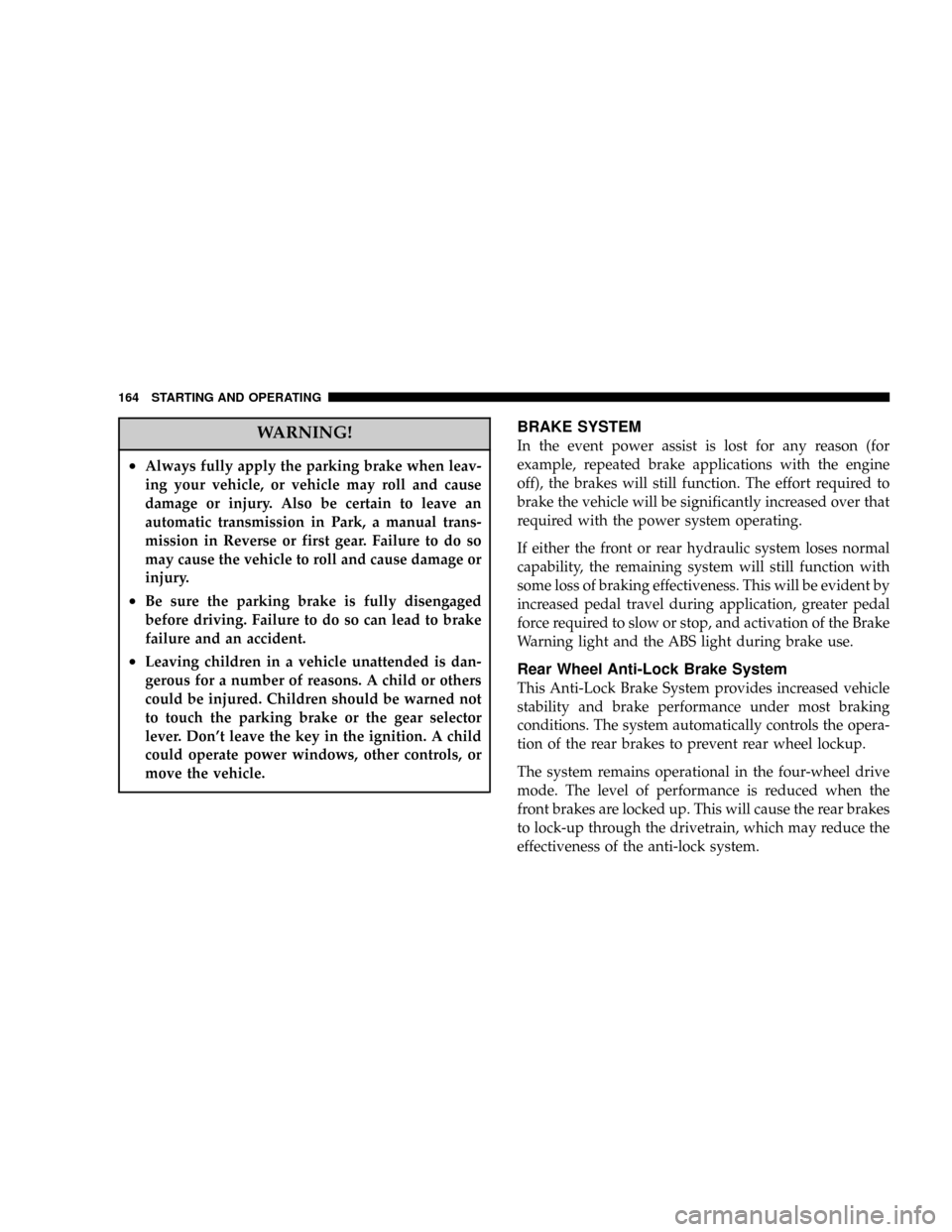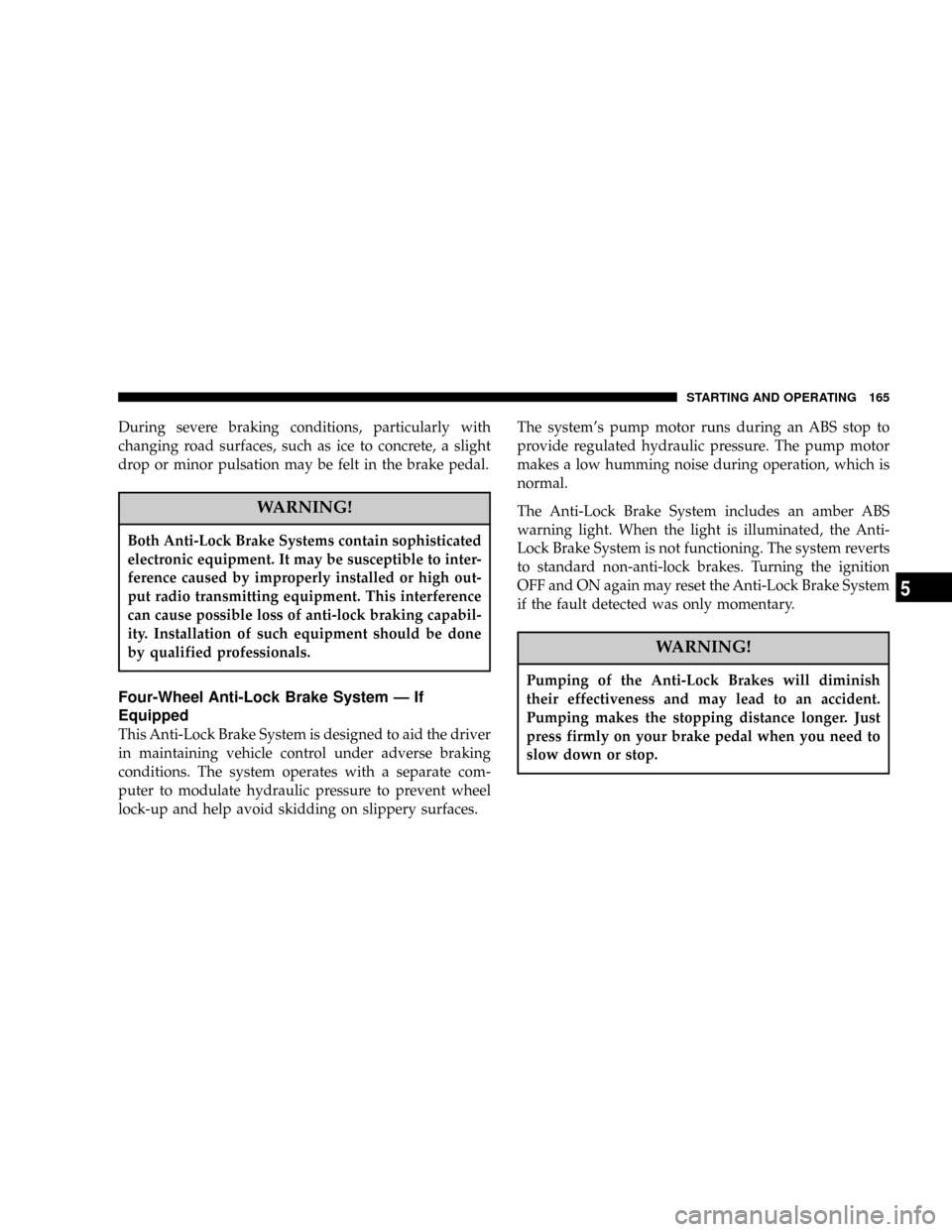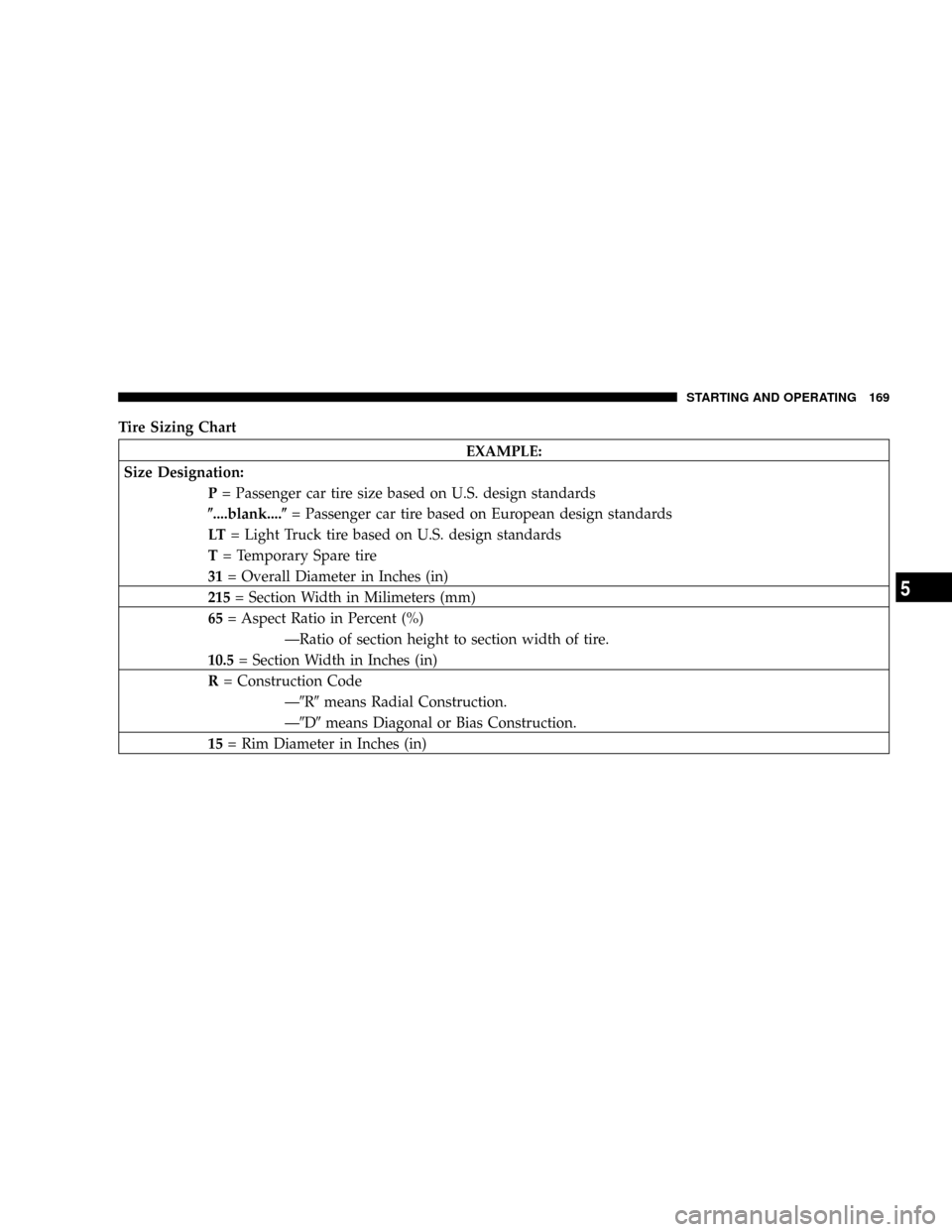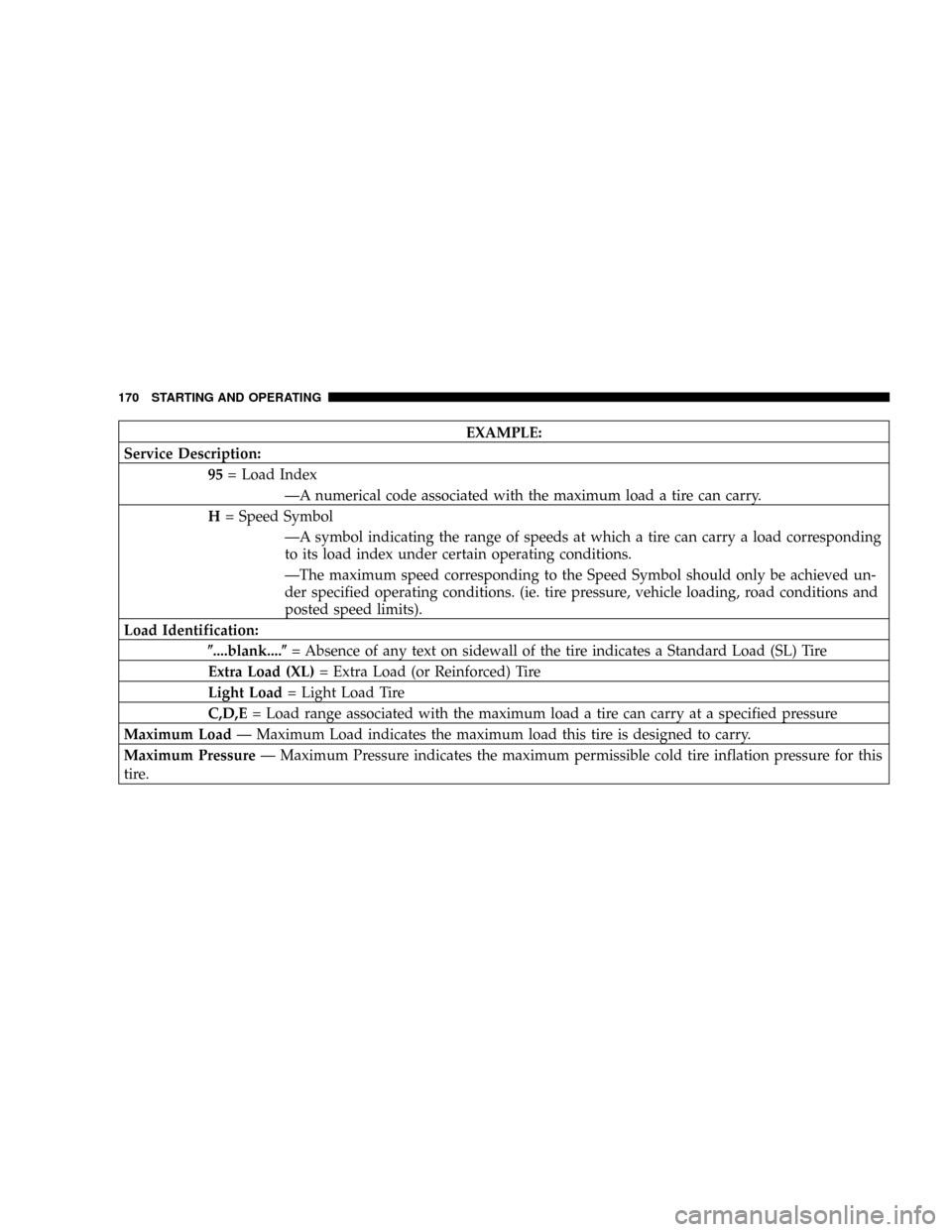2004 DODGE DAKOTA light
[x] Cancel search: lightPage 164 of 300

WARNING!
²Always fully apply the parking brake when leav-
ing your vehicle, or vehicle may roll and cause
damage or injury. Also be certain to leave an
automatic transmission in Park, a manual trans-
mission in Reverse or first gear. Failure to do so
may cause the vehicle to roll and cause damage or
injury.
²Be sure the parking brake is fully disengaged
before driving. Failure to do so can lead to brake
failure and an accident.
²Leaving children in a vehicle unattended is dan-
gerous for a number of reasons. A child or others
could be injured. Children should be warned not
to touch the parking brake or the gear selector
lever. Don't leave the key in the ignition. A child
could operate power windows, other controls, or
move the vehicle.
BRAKE SYSTEM
In the event power assist is lost for any reason (for
example, repeated brake applications with the engine
off), the brakes will still function. The effort required to
brake the vehicle will be significantly increased over that
required with the power system operating.
If either the front or rear hydraulic system loses normal
capability, the remaining system will still function with
some loss of braking effectiveness. This will be evident by
increased pedal travel during application, greater pedal
force required to slow or stop, and activation of the Brake
Warning light and the ABS light during brake use.
Rear Wheel Anti-Lock Brake System
This Anti-Lock Brake System provides increased vehicle
stability and brake performance under most braking
conditions. The system automatically controls the opera-
tion of the rear brakes to prevent rear wheel lockup.
The system remains operational in the four-wheel drive
mode. The level of performance is reduced when the
front brakes are locked up. This will cause the rear brakes
to lock-up through the drivetrain, which may reduce the
effectiveness of the anti-lock system.
164 STARTING AND OPERATING
Page 165 of 300

During severe braking conditions, particularly with
changing road surfaces, such as ice to concrete, a slight
drop or minor pulsation may be felt in the brake pedal.
WARNING!
Both Anti-Lock Brake Systems contain sophisticated
electronic equipment. It may be susceptible to inter-
ference caused by improperly installed or high out-
put radio transmitting equipment. This interference
can cause possible loss of anti-lock braking capabil-
ity. Installation of such equipment should be done
by qualified professionals.
Four-Wheel Anti-Lock Brake System Ð If
Equipped
This Anti-Lock Brake System is designed to aid the driver
in maintaining vehicle control under adverse braking
conditions. The system operates with a separate com-
puter to modulate hydraulic pressure to prevent wheel
lock-up and help avoid skidding on slippery surfaces.The system's pump motor runs during an ABS stop to
provide regulated hydraulic pressure. The pump motor
makes a low humming noise during operation, which is
normal.
The Anti-Lock Brake System includes an amber ABS
warning light. When the light is illuminated, the Anti-
Lock Brake System is not functioning. The system reverts
to standard non-anti-lock brakes. Turning the ignition
OFF and ON again may reset the Anti-Lock Brake System
if the fault detected was only momentary.
WARNING!
Pumping of the Anti-Lock Brakes will diminish
their effectiveness and may lead to an accident.
Pumping makes the stopping distance longer. Just
press firmly on your brake pedal when you need to
slow down or stop.
STARTING AND OPERATING 165
5
Page 167 of 300

ROCKING THE VEHICLE
If vehicle becomes stuck in snow, sand, or mud, it can
often be moved by a rocking motion. Move the gear
selector rhythmically between FIRST and REVERSE,
while applying slight pressure to the accelerator.
The least amount of accelerator pedal pressure to main-
tain the rocking motion without spinning the wheels or
racing the engine is most effective. Allow the engine to
idle with the transmission selector in NEUTRAL for at
least one minute after every five rocking-motion cycles.
This will minimize overheating and reduce the risk of
transmission failure during prolonged efforts to free a
stuck vehicle.
TIRE SAFETY INFORMATION
Tire Markings
STARTING AND OPERATING 167
5
Page 168 of 300

NOTE:
²
P(Passenger)-Metric tire sizing is based on U.S. design
standards. P-Metric tires have the letter ªPº molded
into the sidewall preceding the size designation. Ex-
ample: P215/65R15 95H.
²European Metric tire sizing is based on European
design standards. Tires designed to this standard have
the tire size molded into the sidewall beginning with
the section width. The letter9P9is absent from this tire
size designation. Example: 215/65R15 96H
²LT(Light Truck)-Metric tire sizing is based on U.S.
design standards. The size designation for LT-Metric
tires is the same as for P-Metric tires except for the
letters ªLTº that are molded into the sidewall preced-
ing the size designation. Example: LT235/85R16.
²Temporary Spare tires are high pressure compact
spares designed for temporary emergency use only.
Tires designed to this standard have the letter ªTº
molded into the sidewall preceding the size designa-
tion. Example: T145/80D18 103M.
²High Flotation tire sizing is based on U.S. design
standards and begins with the tire diameter molded
into the sidewall. Example: 31x10.5 R15 LT.
168 STARTING AND OPERATING
Page 169 of 300

Tire Sizing Chart
EXAMPLE:
Size Designation:
P= Passenger car tire size based on U.S. design standards
(....blank....(= Passenger car tire based on European design standards
LT= Light Truck tire based on U.S. design standards
T= Temporary Spare tire
31= Overall Diameter in Inches (in)
215= Section Width in Milimeters (mm)
65= Aspect Ratio in Percent (%)
ÐRatio of section height to section width of tire.
10.5= Section Width in Inches (in)
R= Construction Code
Ð9R9means Radial Construction.
Ð9D9means Diagonal or Bias Construction.
15= Rim Diameter in Inches (in)
STARTING AND OPERATING 169
5
Page 170 of 300

EXAMPLE:
Service Description:
95= Load Index
ÐA numerical code associated with the maximum load a tire can carry.
H= Speed Symbol
ÐA symbol indicating the range of speeds at which a tire can carry a load corresponding
to its load index under certain operating conditions.
ÐThe maximum speed corresponding to the Speed Symbol should only be achieved un-
der specified operating conditions. (ie. tire pressure, vehicle loading, road conditions and
posted speed limits).
Load Identification:
(....blank....(= Absence of any text on sidewall of the tire indicates a Standard Load (SL) Tire
Extra Load (XL)= Extra Load (or Reinforced) Tire
Light Load= Light Load Tire
C,D,E= Load range associated with the maximum load a tire can carry at a specified pressure
Maximum LoadÐ Maximum Load indicates the maximum load this tire is designed to carry.
Maximum PressureÐ Maximum Pressure indicates the maximum permissible cold tire inflation pressure for this
tire.
170 STARTING AND OPERATING
Page 182 of 300

SUPPLEMENTAL TIRE PRESSURE INFORMATION
A light load vehicle condition is defined as two passen-
gers {150 lbs (68 kg) each} plus 200 lbs (91kg) of cargo.
Cold tire inflation pressures for a lightly loaded vehicle
will be found on a ªSupplemental Tire Pressure Inflationº
label located on the face of the driver's door or in the Tire
Information Pressures pamphlet in the glove box.
TIRE CHAINS
Use only Class S chains, or other traction aids that meet
SAE specifications. Chains must be the proper size for the
vehicle as recommended by the chain manufacturer.
These cautions apply to all chain traction devices, includ-
ing link and cable (radial) chains.
CAUTION!
To avoid damage to your vehicle, tires or chains observe the following
precautions:
²Because of restricted chain clearance between tires and other suspen-
sion components, it is important that only chains in good condition
are used. Broken chains can cause serious damage. Stop the vehicle
immediately if noise occurs that could indicate chain breakage.
Remove the damaged parts of the chain before further use.
²Install chains as tightly as possible and then retighten after driving
about 1/2 mile (0.8 km).
²Do not exceed 30 mph (48 km/h).²Drive cautiously and avoid severe turns and large bumps, especially
with a loaded vehicle.
²Install only Class S chains on 4x2 and 4x4 vehicles.²Do not install tire chains on the front wheels of 4x2 vehicles.²Do not install tire chains or traction devices on rear wheels of 4x2
vehicles with tires larger than LT225/75R16. These tires are too large
for sufficient body clearance with chains or other traction devices.
²Do not install tire chains or traction devices on front wheels of 4x4
models with tires larger than LT225/75R16. Do not install tire chains
or traction devices on rear wheels of 4x4 models with tires larger than
LT225/75R16. These tires are too large for sufficient body clearance
with chains or other traction devices.
²Do not drive for a prolonged period on dry pavement.²Tire chains are not allowed on 4x2 vehicles equipped with P255/65R16
or P255/55R17 tires or 4x4 vehicles equipped with P265/70R16 tires.
²Observe the tire chain manufacturer's instructions on method of
installation, operating speed, and conditions for usage. Always use
the lower suggested operating speed if both the chain manufacturer
and the vehicle manufacturer suggest a maximum speed.
182 STARTING AND OPERATING
Page 184 of 300

Follow the recommended tire rotation frequency for your
type of driving found in the ªMaintenance Schedulesº
Section of this manual. More frequent rotation is permis-
sible if desired. The reasons for any rapid or unusual
wear should be corrected prior to rotation being per-
formed.
FUEL REQUIREMENTS
Your engine is designed to meet all emissions regulations
and provide excellent fuel economy and performance
when using high quality unleaded ªregularº gasoline
having an octane rating of 87. The routine use of pre-
mium gasoline is not recommended. Under normal con-
ditions the use of premium fuel will not provide a benefit
over high quality regular gasolines and in some circum-
stances may result in poorer performance.
Light spark knock at low engine speeds is
not harmful to your engine. However, con-
tinued heavy spark knock at high speeds
can cause damage and immediate service
is required. Engine damage resulting from
operation with a heavy spark knock may
not be covered by the new vehicle warranty.Poor quality gasoline can cause problems such as hard
starting, stalling and hesitations. If you experience these
symptoms, try another brand of ªregularº gasoline be-
fore considering service for the vehicle.
Over 40 auto manufacturers world-wide have issued and
endorsed consistent gasoline specifications (the World-
wide Fuel Charter, WWFC) to define fuel properties
necessary to deliver enhanced emissions, performance
and durability for your vehicle. The manufacturer recom-
mends the use of gasolines that meet the WWFC speci-
fications if they are available.
Reformulated Gasoline
Many areas of the country require the use of cleaner
burning gasoline referred to as ªReformulated Gasoline.º
Reformulated gasolines contain oxygenates, and are spe-
cifically blended to reduce vehicle emissions and im-
prove air quality.
The manufacturer strongly supports the use of reformu-
lated gasolines. Properly blended reformulated gasolines
will provide excellent performance and durability for the
engine and fuel system components.
184 STARTING AND OPERATING